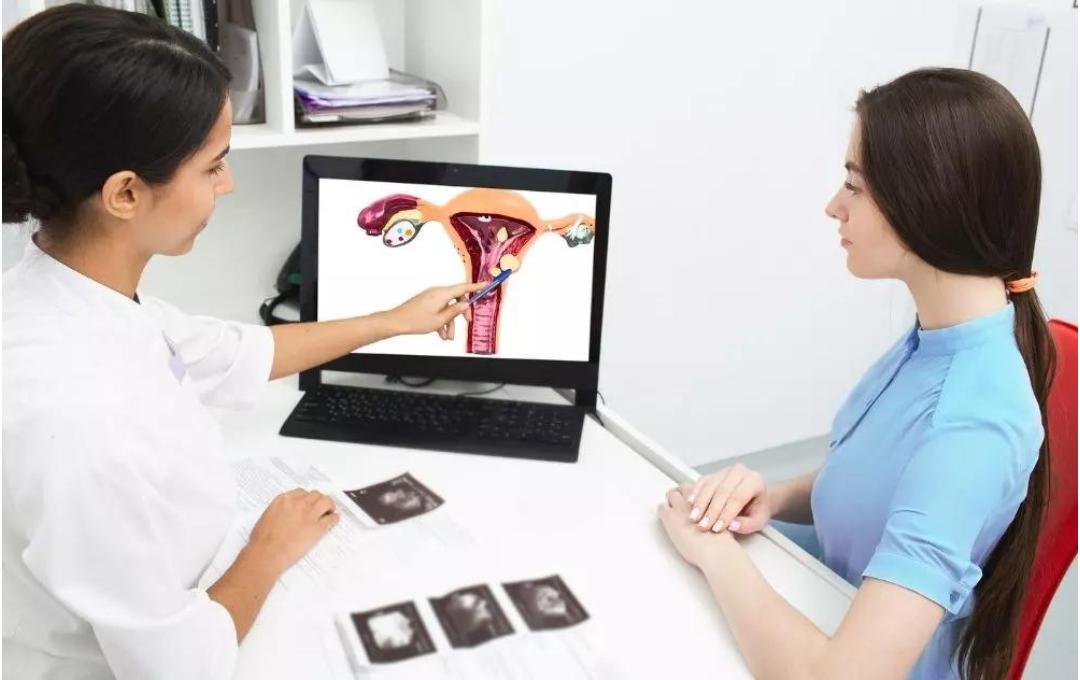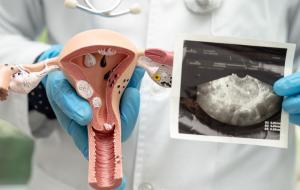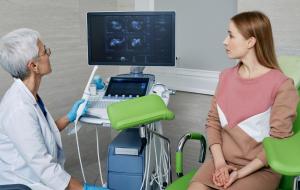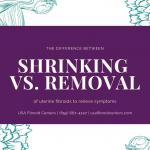
UFE effectively shrinks fibroids with surgery. But what exactly happens when a fibroid is treated using UFE?
This blog will cover:
- What is UFE?
- Benefits of UFE
- How Quickly Will Fibroids Shrink After UFE?
- Signs that Your Fibroids Are Shrinking
- What Happens to Fibroid Tissue and the Uterus After UFE?
- Will Fibroids Disappear Completely After UFE?
- Can Fibroids Regrow After UFE Treatment?
Many women with uterine fibroids suffer from challenging symptoms that disrupt their daily lives. Fibroid symptoms may include heavy periods, painful cramps, anemia, frequent urination, painful intercourse, constipation, or an enlarged abdomen. When fibroid symptoms become severe, they can cause women to call in sick to work, cancel social engagements, avoid intimate relations, and experience mental distress.

If you suffer from painful or uncomfortable fibroid symptoms, we want you to know that help is available. USA Fibroid Centers offers a minimally invasive, non-surgical treatment called uterine fibroid embolization (UFE). Our UFE procedure can safely shrink your fibroids, quickly alleviating pain and providing symptomatic relief in the following weeks and months without the potential risks and side effects of fibroid surgery.
In this article, we discuss what to expect during and after the uterine fibroid embolization procedure. For additional information about UFE and how fibroid treatment can improve your quality of life, consult one of our experienced fibroid specialists.
CALL TO SCHEDULE A CONSULTATION
What Is UFE?
Uterine fibroid embolization, also known as UFE, is a minimally invasive fibroid treatment. This FDA-approved, office-based treatment is performed in an outpatient setting with local anesthesia and mild sedation. The UFE procedure takes less than an hour, allowing patients to return home the same day after a brief observation period. UFE recovery generally takes one to two weeks.
During UFE:
- One of our skilled interventional radiologists uses real-time imaging to guide a tiny catheter into the main uterine artery that supplies blood and nutrients to the fibroid(s).
- Next, we inject embolic (synthetic) materials into the uterine artery to block the fibroid’s blood flow. Since these materials remain at the treatment site permanently, fibroids treated with UFE are unlikely to regrow.
- After the catheter is removed a small bandage is placed over the entry point. Stitches are unnecessary.
- To ensure your continued safety and comfort, we will monitor you on-site for a short period until you are ready to go home.
Following your uterine fibroid embolization procedure, your fibroids will begin to shrink. Some of your symptoms may improve immediately, while others may take up to several months to resolve. If you have concerns about your healing progress after UFE, contact your fibroid specialist.
WHAT TO EXPECT AT HOME AFTER UFE
Benefits of Uterine Fibroid Embolization
If you have avoided fibroid treatment because you wish to avoid or are fearful of surgery, you are not alone. Many women with fibroids believe hysterectomy (the complete surgical removal of the uterus) is their only treatment option, but this is rarely the case. We want to help you understand all available options (including surgical and non-surgical methods) to make an informed decision about your treatment.
Non-surgical UFE treatment offers many benefits compared to hysterectomy. Some benefits of UFE include:
- Minimally invasive: Since UFE is a non-surgical treatment, it involves less pain than traditional fibroid surgeries. Although you may require prescription pain medication during the first part of your recovery, many women can manage post-procedure pain with over-the-counter pain relievers.
- Office-based treatment: Uterine fibroid embolization is performed as an outpatient procedure in a clinic setting. There is no need for a hospital stay.
- A short recovery: Recovery from the UFE procedure takes only one to two weeks. By comparison, recovery from a hysterectomy can last six to eight weeks.
- Less risk than surgery: Surgical risks from hysterectomy include infection, excessive bleeding, blood clots, and an adverse reaction to anesthesia. Since UFE is a minimally invasive procedure that does not require general anesthesia, it is unlikely that you would experience any of these issues.
- Preserves fertility: Many women wish to retain their uterus—particularly women of childbearing age. Unlike hysterectomy, uterine fibroid embolization leaves the uterus and surrounding organs intact, offering the possibility of future pregnancy.
- Alleviates symptoms: UFE can provide relief from difficult fibroid symptoms like heavy bleeding and painful menstrual cramps. Some symptoms can begin to improve immediately following treatment.
- A high success rate: USA Fibroid Centers’ fibroid specialists maintain a 99 percent success rate with the UFE procedure. To find out what to expect after UFE fibroid shrinkage, speak to one of our experts.
How Quickly Will Fibroids Shrink After UFE?

Fibroid shrinkage after UFE begins immediately following treatment, but can continue for some time. Although some of your symptoms may resolve shortly after the UFE procedure, others can take months to improve.
If you suffer from heavy menstrual bleeding due to fibroids, you may be relieved to learn that many women skip a period or two after UFE. Once periods return, they are typically lighter, shorter, and follow more regular cycles than before treatment.
Symptoms and Signs that Your Fibroids Are Shrinking

After your initial recovery of one to two weeks, you will likely notice tangible indicators of fibroid shrinkage after UFE. These will vary depending on which fibroid symptoms you have experienced.
Common fibroid shrinking symptoms include:
- Lighter, shorter periods
- Regular menstrual cycles
- Fewer menstrual cramps
- Less swelling in the abdominal area
- Less back pain, if any
- Normal urination and bowel movements
- Less pain during sex, if any
- Resolution of anemia, including weakness and fatigue
Schedule an appointment with a fibroid specialist to discuss symptoms of shrinking fibroids you may experience.
What Happens to Fibroid Tissue and the Uterus After UFE?
The UFE procedure permanently blocks the blood supply to treated fibroids, causing fibroid tissue to shrink over time until it is reabsorbed by the body. In rare cases, women may pass pieces of fibroid vaginally after UFE. This process, known as fibroid expulsion, is most common after treating submucosal fibroids (fibroids that grow beneath the uterine lining). Fibroid expulsion is most likely to occur within three months of UFE.
Many women considering fibroid treatment express concern about the health of their uterus after UFE. Although embolic materials will remain at the treatment site to prevent fibroid regrowth, your uterus will be left intact. Surrounding structures, such as the ovaries, fallopian tubes, and cervix, should be similarly unharmed.
If you are planning to become pregnant following fibroid treatment, be sure to share your plans with a fibroid specialist beforehand. Many women are able to have successful pregnancies following uterine fibroid embolization.
Will Fibroids Disappear Completely After UFE?
While treatment results vary, your fibroids usually shrink by 50 percent after a UFE procedure. As they should shrink and become softer, relieving pressure on the uterus and surrounding structures. The amount of shrinkage that occurs depends on a number of factors, including the size and number of fibroids, the woman’s age, and her overall health. Women who are younger and have smaller fibroids tend to experience more shrinkage.
Even if fibroids do not disappear completely after UFE, they should shrink enough to no longer cause symptoms. This is why UFE is a good option for women who want to avoid surgery but still want relief from their fibroid symptoms. A UFE’s primary goal is to provide symptomatic relief from fibroids. Once your symptoms improve, you can return to normal daily activities—even if traces of the fibroid(s) remain.
Consult our leading fibroid specialists for an expert assessment of what to expect after UFE.
Can Fibroids Regrow After UFE Treatment?
It is rare for fibroids to regrow after uterine fibroid embolization. Studies have shown that the risk of fibroid regrowth after UFE is less than 5%.
If fibroids do regrow after UFE, they are likely to grow very slowly. In addition, these new fibroids may not cause you to experience any symptoms. However, it is important to have regular checkups with your doctor to monitor your fibroids and make sure they are not causing any problems.
Schedule Consultation at USA Fibroid Centers
If you are suffering from fibroid symptoms, there is no need to wait any longer. At USA Fibroid Centers, we specialize in uterine fibroid embolization (UFE), UFE is a minimally invasive, non-surgical treatment that can effectively shrink fibroids, alleviate painful and burdensome symptoms, and improve your quality of life. It’s a safe and effective treatment option for women of all ages, including those who want to preserve their fertility.
Here are just a few of the benefits of UFE:
- Fast relief from symptoms: Most women experience significant relief from their fibroid symptoms within days of UFE.
- Shorter recovery: UFE is performed through a small catheter inserted into the groin. There is no need for general anesthesia or a hospital stay.
- Non-surgical: UFE does not involve cutting or incisions.
- High success rate: UFE is very effective at shrinking fibroids and relieving symptoms.
- Preserves fertility: UFE can be a good option for women who want to preserve their fertility.
To learn more about how uterine fibroid embolization can improve your life, schedule an initial consultation with a fibroid specialist at USA Fibroid Centers. Our experts can review your symptoms, provide a professional diagnosis, and create a personalized treatment plan based on your situation. We provide UFE treatment in dozens of state-of-the-art clinics across the United States. Contact us today to start your path toward freedom from fibroid symptoms.



